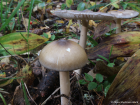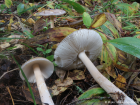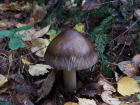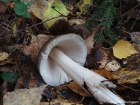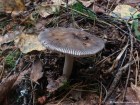Cap starts off egg-shaped, becoming convex, and then flattening while still keeping a shallow umbo. It has pronounced striations at the margin, often featuring a narrow dark band where the striations begin. The cap colour consists of a range of grey-brown shades, with the centre darkening as the fruit body matures. Occasionally, velar fragments may be present when the mushroom is young. Gills free from the stem or slightly attached to it, creamy white, close or crowded. There are often a few short gills, of variable length and irregularly distributed. Stem white or tinged with the cap colour, tapering only slightly (narrower near the cap). The base is enclosed in a sacklike, persistent, white volva with orange-brown spots. The volva is sometimes buried below ground level or in leaf litter. The stem has no ring. Spore print white.
Microscopic Features: Spores are spherical, smooth, and measure 11-13µm in size. They are inamyloid.
Note: A very similar species occurs in some parts of North America.
Amanita battarrae on the First Nature Web site.
Many mushrooms are poisonous, and some can be lethally toxic. Distinguishing between edible and poisonous mushrooms can be very challenging. Therefore, we strongly advise against consuming wild mushrooms. This website does not contain any information about the edibility or toxicity of mushrooms.
Although efforts have been made to ensure accuracy on this website, the information may contain errors and omissions. Therefore, all content provided is for educational and informational purposes only and should not be relied upon or used as a basis for consuming any plants or mushrooms.
External links are provided for reference only. We do not endorse or take responsibility for the content, advice, or products found on these sites or in any advertisements shown on this website.

